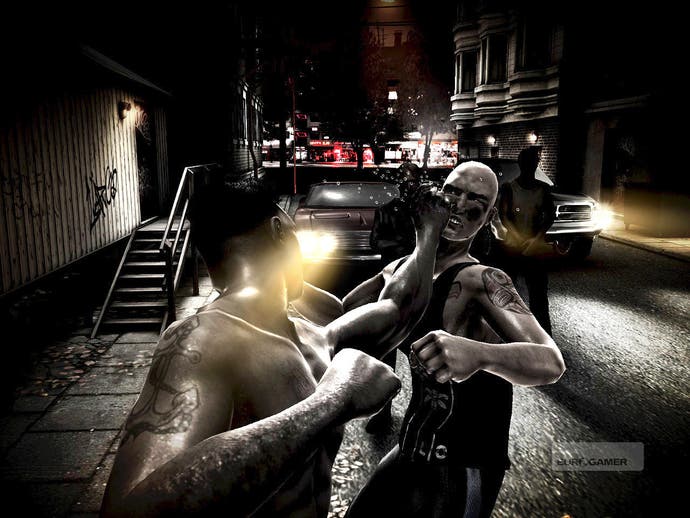PlayStation Move
We only played everything.
Motion Fighter
Motion Fighter drew crowds with its stylish, sharply lit monochrome visuals, a tight over-the-shoulder camera tracking our tattooed Asian boxer as he trades blows with a bandana-wearing biker thug. This bare-knuckle brawler looks like no motion control game you've seen before - very high definition, very grown up, very cool, very PlayStation.
Strange, then, to pick up the two Move controllers and find myself playing a refinement of Wii Sports Boxing, many people's first experience of motion control over three years ago. Or not so strange: it's natural to pick up a motion controller and want to punch stuff, of course, but even the greater technical capabilities of Sony's set-up can only do so much with boxing, where timing is dictated by gesture recognition and animation routines. My moves aren't always accurately represented by my avatar, but there is much less input lag than in Nintendo's game.
After quick and simple calibration - hold both controllers to your chest and press circle - it's into the bout. Simple, forceful gestures initiate straight punches, hooks and uppercuts; a flick won't do, Move sensing how far and fast you throw the punch to determine its force. The uppercut is particularly satisfying, since you need to twist your fist around to execute the blow properly.

Holding both controllers up to your face blocks, leaning dodges, pressing Move's big action buttons and tilting the controllers walks you around, while pressing the triggers and the action buttons during wild gestures executes dirty fighting manoeuvres. You can grab your opponent in a headlock and elbow him in the face by moving as if you were doing just that, or perform a vicious head butt by lurching towards the screen with both hands and your whole body.
The simple interface presents health and stamina bars for both fighters, the latter being used up by strings of moves, but it's my own stamina that runs out first - like Wii Sports Boxing, Motion Fighter (it's a working title) is a very energetic and exhausting game. It looks great and is only 20 per cent complete, but Motion Fighter doesn't quite feel like a standalone release yet.
The Shoot
The least convincing game on display was The Shoot, a basic, movie-themed shooting gallery that combines pointer aiming with a handful of gesture-triggered special moves. Using Move in this way is exactly like aiming with the Wii remote; anyone who's played one of the Wii's excellent "light gun" games like House of the Dead: Overkill will be instantly at home with the fast and accurate pointer control, guiding the cursor by tilting the wrist rather than aiming down the sights of a gun. The Move controller's curved, comfortable trigger - this is a very ergonomic and well-built peripheral, and very pleasant to hold - is the fire button.
The level available to play has us shooting cartoon robots as they move through a subway station, onto a train and eventually along its roof. 2D cardboard cut-outs of civilians need to be left unmolested, while the robots can be blasted away piece by piece by targeting different parts of their bodies - but the most efficient way to dispatch them is to "headshot" them in their glowing eyes, which makes them explode.
You can also flick the Move controller side to side to dodge (though only in certain sections), slam it down to send out a shockwave, or twirl it once to start a brief period of slow-motion if things get too hectic. It's the same old gesture control we're used to - not quite instant, not quite reliable - although it does seem a smidgeon snappier on Sony's device.
Move isn't the problem with The Shoot, however. That would be the amateurish, low-grade graphics, clumsy scripting, and lack of imagination in the enemy patterns or level design. As a proof of concept it's fine, but if Sony wants to avoid giving the impression that Move will suffer the same flood of cheap and cheesy cash-ins that the Wii has, it shouldn't be showing games like this.
